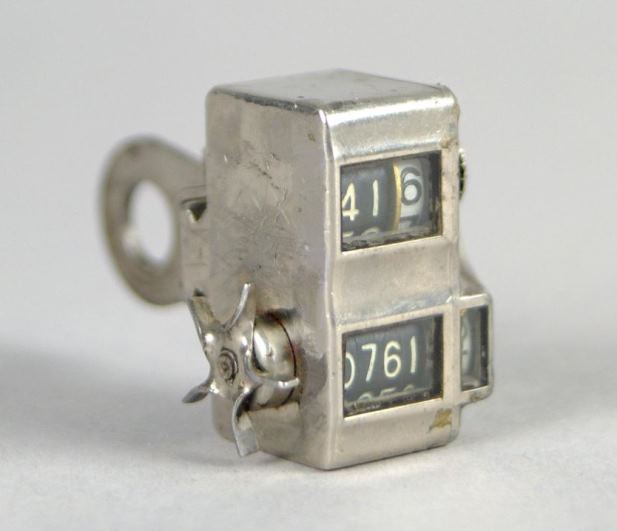By Mary Muller & Erin Strogoff

“Curtis Veeder, Inventor of the Cyclometer, Riding a Bicycle,” drawn by HH Art Studios Inc. for G. Fox & Co. 100th Anniversary, 1947 – Connecticut Historical Society
Because he was born in Pennsylvania in 1862, Curtis Veeder cannot really be considered a “Yankee,” but Veeder’s career reflects the talents and characteristics associated with that stereotype. He showed a talent and interest in all things mechanical from an early age. Even as a boy he experimented with metal casting and put together a small steam engine. He also built and operated a small waterwheel, a wood-turning lathe, and a foot-powered jigsaw. Veeder had an early and avid interest in cycling and made his own high-wheel bicycle when he was just 18 and still in high school. His first patent was for a bicycle seat made of flexible leather stretched over a steel spring frame. After initially refusing to sell his idea to the Pope Manufacturing Co. of Hartford for $200, he continued to make changes and adjustments and two years later sold them the patent, with improvements, for $1000. He also sold the English patent rights to a company in Birmingham, England.
After graduating from Lehigh University with a degree in mechanical engineering in 1886, Veeder worked for the Pope Company for a short time, then spent several years away from Connecticut designing and patenting an array of inventions. These included an electrical hoist for the mining industry and an automatic regulating apparatus for naval searchlights. Veeder also designed the first electric locomotive to be put into regular use on standard tracks in the United States. Veeder’s signature invention was the “cyclometer,” a counting device which allowed bicycle riders to measure the distance traveled. Rather than sell it to the Pope Mfg. Co. to produce, he decided to manufacture it himself, and started the Veeder Manufacturing Company on August 15, 1895. The company grew rapidly as Veeder perfected an automatic casting machine which made parts for cyclometers as well as odometers, and various other machines, including voting machines, telephones, and cash registers. Further growth resulted from the perfection of the design for a tachometer (a speed indicator or counter used in automobiles). In 1928, Veeder Manufacturing merged with the Root Company of Bristol to form Veeder-Root, a company still in business today making gauges and measuring equipment for the fuel and petroleum industries. Curtis Veeder’s house, built between 1925 and 1928 at One Elizabeth Street in Hartford, is now home to the Connecticut Historical Society.
Mary Muller is Lead Museum Educator at the Connecticut Historical Society.
Erin Strogoff, formerly Coordinator of Youth and Family Programs at the CHS, teaches Social Studies at St. Edward School in Stafford Springs, CT.
© Connecticut Public Broadcasting Network and Connecticut Historical Society. All rights reserved. This article originally appeared on Connecticut History | WNPR News
Note: ConnecticutHistory.org does not edit content originally published on another platform and therefore does not update any instances of outdated content or language.









